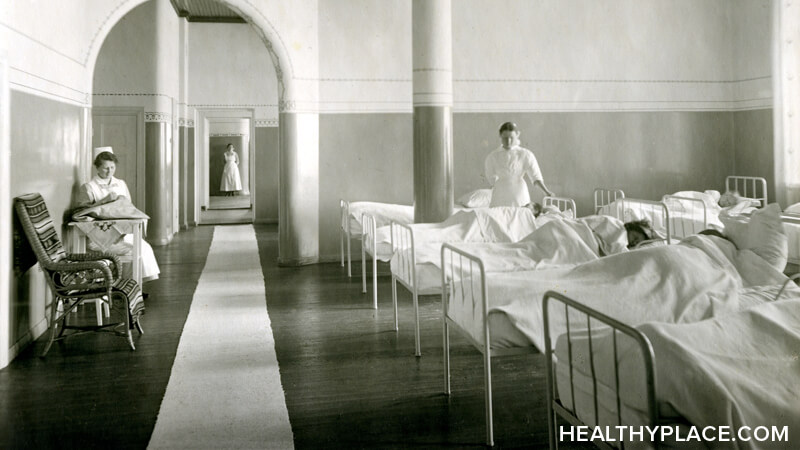The History of Mental Illness

The history of mental illness goes back as far as written records and perhaps took its first major leap forward in 400 B.C. when Greek physician, Hippocrates, began to treat mental illness as physiological diseases rather than evidence of demonic possession or displeasure from the gods as they had previously been believed to be. Asylums for the mentally ill were established as early as the 8th century by Muslim Arabs.
Since then mental illness history has taken many turns and, in the United States, has been a journey from the institutionalization of people with mental illness to moving the mentally ill into the community (modern-day Housing for the Mentally Ill: Where to Find It).
The Early History of Mental Illness
The early history of mental illness happens in Europe where, in the Middle Ages, the mentally ill were granted their freedom in some places if they were shown not to be dangerous. In other places, the mentally ill were treated poorly and said to be witches.
In the 1600s, Europeans began to isolate those with mental illness, often treating them inhumanly and chaining them to walls or keeping them in dungeons. The mentally ill were often housed with the disabled, vagrants and delinquents.
Concern over the treatment of the mentally ill increased over the 1700s and some positive reforms were enacted. In some places, shackling of the mentally ill was now forbidden and people were allowed in "sunny rooms" and encouraged to exercise on the grounds. In other places, serious mistreatment of the mentally ill still occurred.
Mental Illness History in the 1800s
In the United States, people with mental illness were often incarcerated with criminals and left unclothed in darkness without heat or bathrooms, often to be chained and beaten. At this time, U.S. reformer, Dorothea Dix, pushed to establish 32 state hospitals for the mentally ill. Unfortunately, hospitals and humane treatment of the mentally ill did not cure them as previously expected and this led to overcrowding and an emphasis on custodial care rather than humane treatment.
In the 1880s, German psychiatrist, Emil Kraepelin, started to scientifically study mental illness and separated manic-depressive psychosis from schizophrenia in a way that remains to this day.
History of Mental Illness Treatment in the 20th Century
In the early 20th century, Clifford Beers released an autobiography that details the degrading and dehumanizing treatment he received in a Connecticut mental institution. He spearheaded the founding of what would become the National Mental Health Association, later renamed Mental Health America, the largest umbrella organization for mental health and mental illness in the United States today.
In the 1930s, mental illness treatments were in their infancy and convulsions, comas and fever (induced by electroshock, camphor, insulin and malaria injections) were common. Other treatments included removing parts of the brain (lobotomies). The lobotomy was performed widely from the 30s to the 40s to treat schizophrenia, severe anxiety and depression.
In 1946, Harry Truman signed the National Mental Health Act which called for the conducting of research into the mind, the brain and behavior. As a result of this law, the National Institute of Mental Health (NIMH) was formed in 1949. Also in 1949, lithium, the first truly effective drug for mental illness, was introduced and became widely used to treat manic-depression (now known as bipolar disorder).
In 1952, the first antipsychotic drug, chlorpromazine, was discovered and a series of antipsychotics were brought onto the market. These drugs did not cure psychosis but did control its symptoms and 70% of patients with schizophrenia clearly improved on these drugs.
In the mid-1950s the numbers of hospitalized mentally ill peaked at 560,000 in the United States. This, plus the advent of effective psychiatric medication, led to many mentally ill people being removed from institutions and directed towards local mental health facilities. The number of institutionalized mentally ill dropped to 130,000 in 1980.
However, many mentally ill became homeless upon being released from institutions due to inadequate housing and follow-up care.
Also in the 1960s, many critics of psychiatry emerged such as:
- Psychiatrist Thomas Szasz who argues that schizophrenia doesn't exist.
- Erving Goffman who claims that most people in mental hospitals exhibit psychotic symptoms as a result of their hospitalization.
- Ken Kesey who says that patients don't have mental illness but, rather, they simply act in ways society deems unacceptable.
In the 1980s, advocacy groups such as the National Alliance for the Mentally Ill (NAMI) and the National Alliance for Research on Schizophrenia and Depression were formed to advocate for the mentally ill and finance research.
Modern Day Mental Illness
In the modern day, many new psychiatric medications have been introduced and successfully treat most people with mental illness. Very few people are placed in mental hospitals for long periods of time due to lack of funding (primarily from private insurance) and because most people can be successfully treated in the community.
Homelessness and incarceration of the mentally ill continue to be major problems as does the lack of beds and resources to treat people with severe mental illness.
APA Reference
Tracy, N.
(2019, October 23). The History of Mental Illness, HealthyPlace. Retrieved
on 2026, January 9 from https://www.healthyplace.com/other-info/mental-illness-overview/the-history-of-mental-illness



